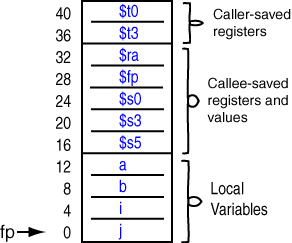Conceptually, the local variables cease to exist when the stack frame that implements them is popped.
Of course, the memory that implemented the stack frame is still there, but in normal operation the variables in it are not accessible.

Register
$30 is reserved,
by software convention,
for use as a frame pointer.
In the extended assembler it has the mnemonic name $fp.
When a subroutine starts running,
the frame pointer points at the frame at the top of the stack.
Variables for the active subroutine are in that stack frame
and are accessed by using the address in $fp.
When the subroutine first becomes active, the frame pointer and the stack pointer both
point at the top of the stack.
(Remember, our stacks grow downward, so in the picture
$fp is correctly pointing at the last word that was pushed onto
the stack, the top of the stack.)
But the stack (and the stack pointer) may be involved in
arithmetic expression evaluation.
This often involves pushing and popping values onto
and off of the stack.
If $sp keeps changing,
it would be hard to access a variable
at a fixed location on the stack.
To make things easy for compilers (and for human assembly language programmers) it is convenient to have a frame pointer that does not change its value while a subroutine is active. The variables are always the same distance from the unchanging frame pointer.
In the subroutine prolog,
the caller's frame pointer is pushed onto the stack
along with the stack pointer and any S registers.
Now the subroutine makes room on the stack for
variables and points the frame pointer
to the top of the stack frame.